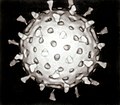Viral envelope

A viral envelope is the outermost layer of many types of viruses.[1] It protects the genetic material in their life cycle when traveling between host cells. Not all viruses have envelopes. A viral envelope protein or E protein is a protein in the envelope, which may be acquired by the capsid from an infected host cell.
Host cell infection process
Numerous human pathogenic viruses in circulation are encased in
The membrane fusion event that triggers viral entrance is caused by the viral
Enveloped viruses enter cells by joining a cellular membrane to their lipid bilayer membrane. Priming by proteolytic processing, either of the fusion protein or of a companion protein, is necessary for the majority of viral fusion proteins. The priming stage then gets the fusion protein ready for triggering by the processes that go along with attachment and uptake, which frequently happens during transport of the fusion protein to the cell surface but may also happen extracellularly. So far, structural studies have revealed two kinds of viral fusion proteins. These proteins are believed to catalyze the same mechanism in both situations, resulting in the fusing of two bilayers. In other words, these proteins operate as enzymes, which while having various structural variations catalyze the same chemical reaction.[2]
Composition
The envelopes are typically derived from portions of the host
For a very long time, it was thought that the spike proteins, which are necessary for infectivity, were directly incorporated into the
Effects on pathogenicity
Envelopes may help viruses avoid the
Ligand-coated viruses stimulate type I IFN signaling, activate TAM receptors on dendritic cells (DCs), and suppress
All enveloped viruses also have a capsid, another protein layer, between the envelope and the genome.[1] The virus wraps its delicate nucleic acid with a protein shell known as the capsid, from the Latin capsa, meaning "box," in order to shield it from this hostile environment. Similar to how numerous bricks come together to form a wall, the capsid is made up of one or more distinct protein types that repeatedly repeat to form the whole capsid. This repetitive pattern creates a robust but rather flexible capsid. The nucleic acid inside the capsid is appropriately protected by its modest size and physical difficulty in opening it. The nucleocapsid of the virion is made up of the nucleic acid and the capsid. Remember that the genomes of most viruses are very small. Genes code for instructions to make proteins, so small genomes cannot code for many proteins. Therefore, the virion capsid consists of one or only a few proteins that repeat over and over to form the structure. The viral nucleic acid would be physically too large to fit inside the capsid if it consisted of more than a few proteins.[12] The capsid, having a focused role of protecting the genome in addition to immune recognition evasion.[13] The viral capsid is known for its protection of RNA before it is inserted into the host cell, unlike the viral envelope which protects the protein capsid.[14]
The cell from which a virus
Vaccination against enveloped viruses can function by neutralizing the glycoprotein activity with antibodies.[16]
Eliminating the virus's ability to form an envelope—by removing or inactivating a structural protein—or to bud has been studied as a method for producing viruses incapable of replication.[17][18][19][20]
Examples of enveloped viruses
The following are some examples of enveloped virus species:
- DNA viruses
- RNA viruses
- Flaviviridae
- Alphaviridae
- Togaviridae
- Coronavirus
- Hepatitis D
- Orthomyxoviruses
- Paramyxoviridae
- Rhabdovirus[21]
- Bunyaviruses
- Filoviruses
- Retroviruses
- Retroviruses
Examples of non-enveloped viruses
The following are some examples of viruses without envelopes:
- DNA viruses
- RNA viruses
- Caliciviruses
- Picornaviruses
- Reoviruses
- Astroviruses
- Hepeviridae
See also
References
- ^ a b HURLBERT, RONALD E. Fundamentals of Microbiology 102. Chapter #11: Viruses. Archived from the original on 2008-11-10. Retrieved 2008-11-07.
- S2CID 3775608.
- PMID 26925438.
- PMID 33727347.
- ^ Gelderblom HR. Structure and Classification of Viruses. In: Baron S, editor. Medical Microbiology. 4th edition. Galveston (TX): University of Texas Medical Branch at Galveston; 1996. Chapter 41. Available from: https://www.ncbi.nlm.nih.gov/books/NBK8174/
- PMID 9394621.
- PMID 23954153.
- PMID 32276357.
- ISBN 978-0-12-374410-4.
- PMID 26935856.
- PMID 26925438.
- PMC 7150055.
- PMID 30037986.
- PMID 20234879.
- PMID 25843687.
- PMID 29522750.
- PMID 39526809.
- PMID 37683004.
- PMID 11023201.
- PMID 39472701.
- ^ "The Rabies Virus". CDC. Archived from the original on 2017-01-18. Retrieved 2008-11-07.
External links
- "Virus Structure". Molecular Expressions: Images from the Microscope. Retrieved 2007-06-27.

